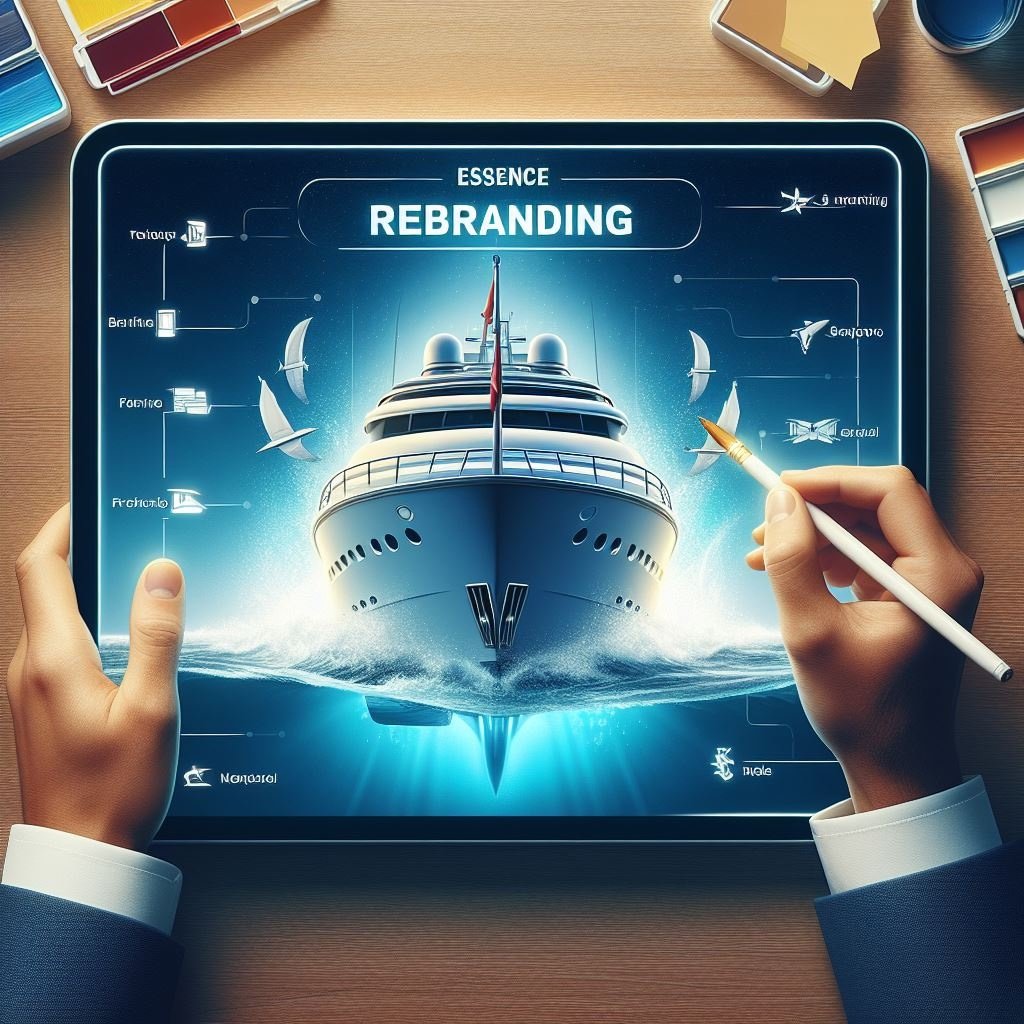What does it mean to rebrand your yacht and why might it be necessary?
July 21, 2024 | by ryy.com

Welcome to this article about rebranding your yacht! In this article, you will learn about what it means to rebrand your yacht and why it might be necessary. Rebranding your yacht involves making changes to its visual identity, such as the name, logo, and design elements. This can be done to refresh the image of your yacht, attract a new audience, or reflect changes in ownership or purpose. So, let’s explore the reasons why rebranding your yacht might be necessary.
Rebranding your yacht may be necessary for various reasons. For example, if your yacht has been in the market for a long time, rebranding can help to create renewed interest and appeal to potential buyers or charterers. It can also be a way to differentiate your yacht from competitors and stand out in a crowded market. Additionally, if there have been major changes in ownership or the yacht’s purpose, rebranding can help to communicate these changes effectively. So, if you’re considering rebranding your yacht, keep reading to learn more about the process and benefits it can bring.https://www.youtube.com/embed/p2EFMLM_H78
Definition of Rebranding
Rebranding refers to the process of changing the brand identity and perception of a product or company. It involves altering various elements such as the name, logo, visual design, and messaging to create a new image and position in the market. Rebranding can be undertaken for various reasons, including updating the product’s appearance, targeting a new audience, or aligning with new market trends. In the context of yachts, rebranding aims to enhance the image and perception of a vessel, attract a new target market, and boost its value and resale potential.
Understanding the Concept of Rebranding
Rebranding is a strategic decision that entails careful consideration of various factors. It is more than just a change in a yacht’s appearance; it involves a comprehensive transformation of the brand’s entire identity. This includes analyzing the target market, understanding their preferences and expectations, and adjusting the brand’s image and messaging to align with these considerations.
Rebranding in the Context of Yachts
In the world of yachts, rebranding can be a significant undertaking. Yachts are not merely vessels; they are luxury symbols, status symbols, and investments. Therefore, rebranding a yacht involves more than just changing its name or appearance. It requires a deep understanding of the yacht’s target market, their desires, and the image they seek to project.
Benefits of Rebranding a Yacht
Enhancing the Image and Perception
One of the primary benefits of rebranding a yacht is the ability to enhance its image and perception. By conducting market research and analysis, yacht owners and operators can identify areas for improvement and make the necessary changes to create a more appealing brand. This can lead to increased interest and demand from potential buyers or charter clients.
Attracting a New Target Market
Rebranding can also help yachts attract new target markets. By understanding shifting consumer preferences and market trends, yacht owners can adjust their brand positioning and messaging to align with these changes. This can open up new opportunities and expand the yacht’s customer base.
Boosting Value and Resale Potential
Rebranding a yacht can have a positive impact on its value and resale potential. A well-executed rebranding strategy can enhance the yacht’s reputation, increase its desirability, and ultimately result in a higher selling price. Additionally, a rebranded yacht can stand out in a competitive market, making it more attractive to potential buyers.
Reasons for Rebranding a Yacht
Updating the Yacht’s Appearance
One common reason for rebranding a yacht is to update its appearance. Over time, design trends and preferences may change, and it becomes necessary to refresh the yacht’s look to remain relevant in the market. This can involve updating the logo, color scheme, or visual elements to reflect a more modern and appealing aesthetic.
Changing Ownership or Management
Another reason for rebranding a yacht is a change in ownership or management. When a yacht undergoes a change in leadership, it may be necessary to redefine the brand to align with the new vision and direction of the owners or operators. This can involve repositioning the yacht in the market and adjusting its branding strategy to reflect the new management’s goals and objectives.
Aligning with New Market Trends
Rebranding can also be driven by the need to align with new market trends. As consumer preferences evolve, yachts may need to adapt to remain competitive and meet the demands of the target market. This can involve adjusting the brand image, messaging, and offerings to align with the latest trends and consumer expectations.
Process of Rebranding
Rebranding a yacht involves a carefully planned and executed process. The steps involved in the rebranding process include:
Conducting Market Analysis and Research
The first step in the rebranding process is conducting a thorough market analysis and research. This includes understanding the current market landscape, identifying target market segments, and analyzing the competition. By gaining insights into the market, yacht owners can identify opportunities and make informed decisions regarding the rebranding strategy.
Developing a New Brand Identity
Once the market research is complete, the next step is to develop a new brand identity. This involves defining the yacht’s brand positioning, personality, and messaging. It includes developing a unique selling proposition and a brand story that resonates with the target market. The brand identity should reflect the yacht’s unique features and offerings, creating a compelling and memorable image in the minds of customers.
Updating Visual Elements
In rebranding a yacht, updating the visual elements is essential. This includes designing a new logo, selecting an appropriate color palette, and creating visual assets that convey the desired brand image. The visual elements should be consistent with the brand identity and appeal to the yacht’s target market.
Implementing New Branding Across Various Platforms
The final step in the rebranding process is implementing the new branding across various platforms. This includes updating the yacht’s website, social media profiles, marketing collateral, and any other communication channels. Consistency is crucial during this phase to ensure a seamless transition from the old brand to the new brand.
Costs and Investments in Rebranding
Rebranding a yacht involves certain costs and investments. These can vary depending on the scope of the rebranding project and the level of professional services required. Some of the common costs associated with rebranding a yacht include:
Budgeting for Rebranding Expenses
Before embarking on a rebranding project, it is essential to establish a budget. This budget should consider the expenses related to market research, brand development, design, and marketing activities. Establishing a budget ensures that the rebranding project remains financially viable and sustainable.
Hiring Professional Services
Rebranding a yacht often requires the expertise of professionals such as brand strategists, graphic designers, and marketing consultants. The cost of hiring these professionals should be factored into the rebranding budget. Working with professionals ensures a high-quality and cohesive rebranding strategy that aligns with the yacht’s goals and objectives.
Potential Return on Investment
While rebranding can be a significant investment, it has the potential to yield a positive return on investment. A well-executed rebranding strategy can attract new customers, increase the yacht’s value, and generate higher revenue. It is important to carefully consider the potential return on investment when evaluating the costs associated with rebranding.
Challenges and Considerations in Rebranding
Rebranding a yacht comes with its own set of challenges and considerations. Some of these include:
Maintaining Continuity with Existing Customers
One of the challenges in rebranding is maintaining continuity with existing customers. It is important to ensure that the rebranding strategy does not alienate loyal customers or create confusion. Strategies such as gradually introducing the new brand elements, effective communication, and personalized outreach can help maintain a strong relationship with existing customers throughout the rebranding process.
Managing Stakeholder Expectations
Involving the yacht’s stakeholders, such as owners, investors, and employees, in the rebranding process is crucial. Clear communication and managing stakeholder expectations can help align everyone’s vision and ensure a smooth transition. It is important to address any concerns or resistance from stakeholders and provide them with a clear understanding of the benefits and objectives of the rebranding strategy.
Potential Risks and Setbacks
Rebranding a yacht carries some inherent risks and potential setbacks. These can include negative customer reactions, a temporary decrease in sales, or the perception of instability. Careful planning and execution, along with effective communication, can minimize these risks and ensure a successful rebranding process.
Successful Examples of Yacht Rebranding
Case Study: Transforming a Classic Yacht into a Modern Luxury Brand
In this case study, a classic yacht with a traditional image underwent a rebranding process to appeal to a modern luxury market. The yacht’s branding strategy was revamped to highlight its unique features and position it as a sophisticated and exclusive destination. The rebranding efforts included updating the yacht’s visual elements, redesigning its website, and creating a compelling brand story that resonated with the target market. The rebranding process resulted in increased market visibility, a more positive customer perception, and improved business performance.
Case Study: Rebranding a Yacht for Increased Charter Business
In this case study, a yacht primarily used for private use underwent a rebranding process to attract more charter business. The yacht’s brand identity was adjusted to emphasize its charter capabilities, highlighting the luxury amenities and personalized services available. The rebranding strategy involved updating the yacht’s visual elements, developing a marketing campaign targeting potential charter clients, and leveraging traditional and digital advertising channels to increase market visibility. As a result, the yacht experienced a significant increase in charter bookings and revenue.
Marketing and Communication Strategies in Yacht Rebranding
Creating a Compelling Brand Story
A crucial aspect of yacht rebranding is creating a compelling brand story that resonates with the target market. A well-crafted brand story communicates the yacht’s unique features, value proposition, and the experience it offers to customers. It helps differentiate the yacht from competitors and creates an emotional connection with potential buyers or charter clients.
Crafting a Strong Marketing Campaign
A strong marketing campaign is essential in rebranding a yacht. This involves developing a comprehensive marketing plan that combines various tactics, such as digital advertising, social media marketing, public relations, and events. The marketing campaign should be aligned with the yacht’s new brand identity and effectively communicate the rebranding message to the target market.
Leveraging Traditional and Digital Advertising Channels
Yacht rebranding requires a strategic approach to advertising and promotion. This involves leveraging both traditional and digital advertising channels to maximize the reach and impact of the rebranding efforts. Traditional advertising methods such as print media, billboards, and television can complement digital channels such as social media, online ads, and influencer partnerships.
Impacts and Outcomes of Rebranding a Yacht
Increased Market Visibility
Rebranding a yacht can lead to increased market visibility. By updating the brand image and implementing effective marketing strategies, a rebranded yacht can generate more attention and interest from potential buyers or charter clients. This increased visibility can result in higher demand and ultimately lead to increased business performance.
Improved Customer Perception and Engagement
A successful rebranding strategy can improve customers’ perception and engagement with the yacht. By aligning the brand identity and messaging with the target market’s preferences, a rebranded yacht can create a stronger emotional connection with customers. This can result in increased customer loyalty, higher satisfaction, and positive word-of-mouth referrals.
Positive Effects on Resale Value
Rebranding a yacht can have a positive impact on its resale value. A well-executed rebranding strategy can enhance the yacht’s reputation, positioning it as a desirable option in the market. This increased desirability can lead to a higher selling price, benefiting the yacht’s owners or investors.
Conclusion
Rebranding a yacht entails a comprehensive transformation of the brand’s identity and image. It involves updating the yacht’s appearance, targeting a new audience, and aligning with market trends. The process of rebranding includes conducting market analysis, developing a new brand identity, updating visual elements, and implementing the new branding across various platforms. While rebranding comes with costs, it offers benefits such as enhancing the yacht’s image, attracting new customers, and boosting its value and resale potential. However, it is important to consider the challenges and risks associated with rebranding and develop effective marketing and communication strategies. Overall, rebranding a yacht can be a necessary and beneficial endeavor to stay relevant and successful in the ever-evolving yacht industry.
RELATED POSTS
View all


